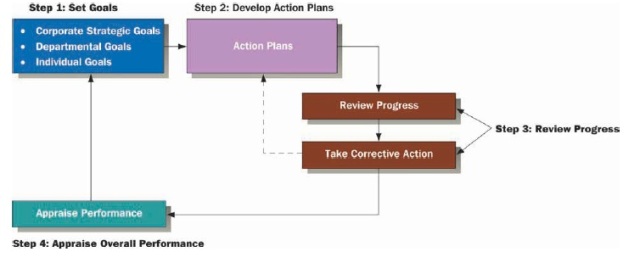Management by Objectives
 Photo courtesy of Kalyan City LifeOpens in new window
Photo courtesy of Kalyan City LifeOpens in new window
Management by objectives is a formal set of procedures that establishes and reviews progress toward common goals for managers and subordinates. |
Described by famous management scholar Peter DruckerOpens in new window in his 1954 book, The Practice of Management, management by objectives has remained a popular and compelling method for defining goals and monitoring progress towards achieving them.
Management by objectives (MBO) is a system whereby managers and subordinates define goals for every department, project, and person and use them to monitor subsequent performance.
The subordinate’s or employee’s subsequent performance is rated according to how well s/he accomplishes those goals.
MBO specifies that superiors and subordinates will jointly set goals for a specified period of time and then meet again to evaluate the subordinate’s performance in terms of the previously established goals. These goals and objectives are linked to the agency’s and the employee’s goals.
 Figure X-1 | Model of the MBO Process
Figure X-1 | Model of the MBO Process
|
A model of the essential steps of the MBO system is presented in Figure X-1. And as indicated, four major activities make MBO successful:
- Set Goals
Setting goals involves employees at all levels and looks beyond day-to-day activities to answer the question, ‘What are we trying to accomplish?’ Managers assign responsibility for goal accomplishment. However, goals should be decided jointly. Mutual agreement between employee and supervisor creates the strongest commitment to achieving goals. In the case of teams, all team members may participate in setting goals.
- Develop Action Plans
An action plan defines the course of action needed to achieve the stated goals. Action plans are made for both individuals and departments.
- Review Progress
A periodic progress review is important to ensure that action plans are working. KPIs often provide the data for the review. These reviews can occur informally between managers and employees, where the organization may wish to conduct three-, six- or nine-month reviews during the year. This periodic check-up allows managers and employees to see whether they are on target or whether corrective action is necessary.
Managers and employees should not be locked into predefined behavior and must be willing to take whatever steps are necessary to produce meaningful results. The point of MBO is to achieve goals. The action plan can be changed whenever goals are not being met.
- Appraise Overall Performance
The final step in MBO is to carefully evaluate whether annual goals have been achieved for both individuals and departments. Success or failure to achieve goals can become part of the performance appraisal system and the designation of salary increases and other rewards.
The appraisal of departmental and overall corporate performance shapes goals for the next year. The MBO cycle repeats itself on an annual basis.
MBO is a process of agreeing on objectives within an organization so management and employees buy in to the objectives and understand what they are. It is all too easy for managers to fail to outline and agree with their employees about what it is everyone is trying to achieve.
MBO substitutes for good intentions a process that requires a rather precise written description of objectives (for the period ahead) and timelines for their monitoring and achievement.
The MBO process requires that the manager and the employee agree to what the employee will attempt to achieve in the period ahead and (very important) that the employee accept and buy in to the objectives (otherwise commitment will be lacking).
For example, let us suppose the manager and the employee agree that it will be sensible to introduce a key performance indicator to show the development of a new free revenue in fire prevention.
Then, the manager and the employee need to discuss what is being planned, what the time schedule is, and what the performance indicators should be. Thereafter, the two will meet regularly to ensure the objective is being attended to and will be delivered on time.
OrganizationsOpens in new window have scarce resources, and so it is incumbent on the managers to consider both the level of resourcing and whether the objectives that are jointly agreed on within the organization are the right ones and represent the best allocation of effort. Also, reliable management information systems are needed to establish relevant objectives and monitor their performance toward the achievement of those objectives in a meaningful way.
The concept of MBO is readily evident in most organizations today, although you may not hear it being referred to as such. The basic concepts of aligning the mission core values and vision of the organization to that of the employees are the basis for most organizational employee relationships. In part, the MBO concept was a foundational piece that created a significant shift in leading and managing.
During the last 25 years, the relationship between labor and management has, to a great degree, shifted to a more collaborative approach. Economic/budget processes are much more defined in respect to short-term goals and long-term strategic objectives, and our collaboration or the creation of synergistic partnerships are in part a result of Drucker’s introduction of MBO.
See Also:
- Research data for this work have been adapted from the manual:
- Management Skills: Assessment and Development By Ricky Griffin, David Van Fleet.

